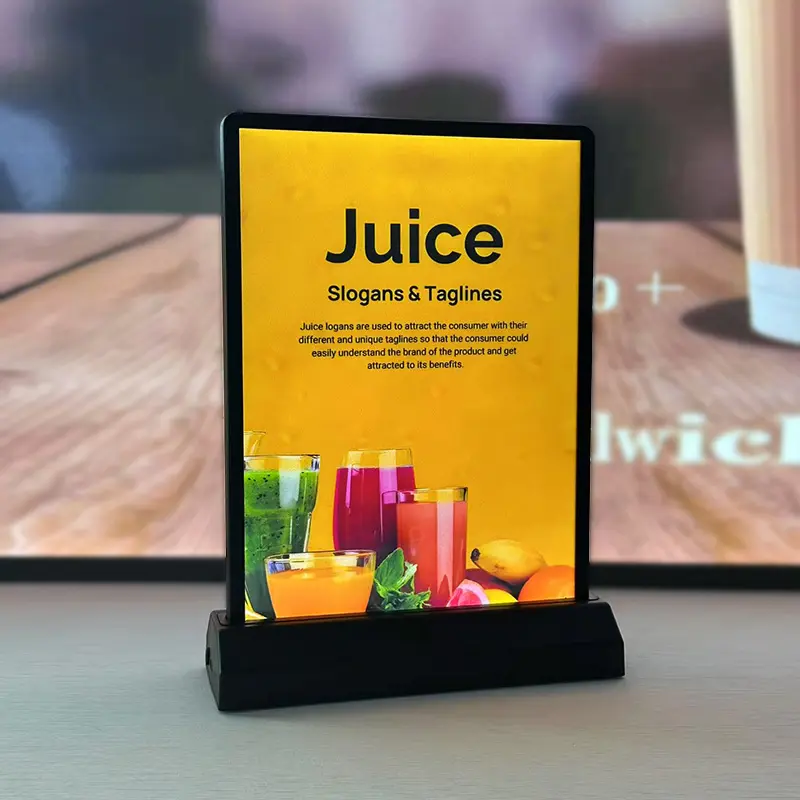Essential Features of Dual-Purpose Lightboxes
Durable Construction Materials
Double-sided LED lightboxes can be used in or outdoors, which require durable build materials that will survive under different environmental pressures. Typical materials used in its construction are aluminum framing and polycarbonate sheets. Rust-proof aluminum is ideal for outdoor use, and polycarbonate is known for its high impact resistance and clear transparency for better visibility. The combination of these materials not only enhances durability but also keeps the lightboxes lightweight. Durable materials like these are re useable for years, thus improving the lifespan of a lightbox greatly by preventing you from having to replace or repair it often, making this product a cost-effective option for businesses in need of dependable displays.
Weatherproofing and Moisture Control
Our outdoor lightboxes have excellent weatherproofing, you really do get what you pay for! Sealed edges, for example, and moisture barriers, are essential for keeping water from getting in and damaging parts inside the enclosure. Gaskets and silicone sealant often are used by manufacturers to help provide the lifespan of these lightboxes with water-related problems. Studies have proven that the better weather sealed poules have far lower failure rates with rain and humidity exposure. This boosts their maintenance efficiency, and so they are better suited for companies in regions that regularly experience rain or high humidity. In this way, outdoor lightboxes are weather-resistant and can maintain their functional integrity.
Best Lightbox Types for Indoor/Outdoor Versatility
LED Illuminated Lightboxes
LED-illuminated light boxes have become the favourite solution thanks to the incredible efficiency and versatility. These lightboxes provide even, bright lighting and they save on energy, and are perfect for indoor or outdoor displays. This sustainable technology not only saves money, but also supports your sustainability initiatives by reducing your carbon footprint. Moreover, LED lightboxes frequently have a dimmable light output so that users can control the intensity of the light depending on the environment, providing all the better visibility. Thanks to their flexibility and environmental considerations, LED illuminated lightboxes are one of the top choices for businesses that want so adopt a modern approach while maintaining energy efficiency.
Modular Snap-Frame Designs
They are also amazing for businesses who have ever changing marketing strategies as they make changing your graphics so easy with a snap frame modular design! These lightboxes make changing out displays easy, saving you time and money on installation since it can be easily changed without the use of tools. This task is also carried out in an intuitive manner, so just keep it on track and don't miss a beat, even through maintenance! And as they’re snap frame lightboxes – they can be produced in a range of sizes and configurations to exactly meet the needs of a space. This means they are an ideal option for businesses wanting to maximise advertising exposure in more than one location.
Durability Factors for Long-Term Outdoor Use
UV-Resistant Components
When selecting outdoor lightboxes, look for UV-stabilised materials and components, which can help preserve both the longevity and appearance of your lightbox. George Outdoor Solutions are solidly constructed and meant to be a long-term solution rather than a faded, shrunken sunburned copy. Many manufacturers combat this problem by adding UV filters directly into the materials they use in construction (like an acrylic or polycarbonate cover), which help absorb and deflect damaging rays. Without this protection, a lightbox can lose significant visual quality in less than a year of outdoor use, so in UV resistance is an investment in a long lasting lightbox.
Corrosion Prevention Techniques
Lightbox elements can corrode over time due to extended exposure to the environment and hence effective anticorrosive methods are needed. Such processes as powder coating and anodizing insulate metal parts against rust and other environmental damage, which can extend the life of your lightbox many times over. These options provide that the frame of the light box will still be usable despite any inclement weather! We suggest periodic checking for early corrosion and any necessary preventive maintenance to help ensure your lightbox remains a dependable marketing tool.
Installation and Maintenance Considerations
Hardwiring vs Plug-in Power Options
Evaluating Your Installation Needs and Lightbox Use Whether to go hardwire, or decide to go plug-n-play youll have to consider the style and use of your light box. Hardwired installations are more appropriate for a non-disconnect situation, and for when you want to reduce clutter, especially if the installation is outside. A good option for Outdoor use lightboxes with the ongoing reliability. On the other hand, seeing plug-in power options being more flexible and having no-wiring-required setups, it is becoming ideal for small indoor use lightboxes, or temporary installation. Fast and flexible, they are easy to relocate, although extra protection may be required to prevent disconnection or harm.
Security and Anti-Tamper Features
Anti-theft and anti-vandalism applied to lightboxes is a must when using them in outdoor enviroments. Deterrence features like locks and anti-tamper devices also help to provide peace of mind when leaving your investment uninformed in public spaces. As statistics suggest that a site unit with strong security features are 40% less likely to face incidents it's obvious that upgrading here can offer a significant peace of mind. The investment into these enhancements ensure the lightbox itself is not only safeguarded but also continues to maintain its strength and reliability over time.
FAQ
What materials make dual-purpose lightboxes durable?
Dual-purpose lightboxes are typically made with aluminum framing and polycarbonate panels, which provide rust resistance, impact resistance, and transparency.
How do outdoor lightboxes maintain performance in harsh weather?
Outdoor lightboxes use features like sealed edges, moisture barriers, gaskets, and silicone sealants for effective weatherproofing to withstand harsh conditions.
Why are LED illuminated lightboxes a preferred choice?
LED illuminated lightboxes are energy-efficient, offer uniform lighting, and come with adjustable brightness settings, making them versatile and eco-friendly.
What are modular snap-frame designs?
Modular snap-frame designs allow for easy graphic changes without specialized tools, making them ideal for businesses with dynamic marketing strategies.
How can lightboxes be protected from UV rays?
UV-resistant components, such as acrylic or polycarbonate covers integrated with UV filters, help maintain a lightbox's visual appeal and durability.
What techniques prevent corrosion in lightboxes?
Techniques like powder coating and anodizing protect metal components from rust and environmental wear, extending the lightbox's lifespan.
What security features are recommended for outdoor lightboxes?
Locks and anti-tamper mechanisms deter vandalism and theft, providing security and peace of mind for outdoor installations.
Table of Contents
- Essential Features of Dual-Purpose Lightboxes
- Best Lightbox Types for Indoor/Outdoor Versatility
- Durability Factors for Long-Term Outdoor Use
- Installation and Maintenance Considerations
-
FAQ
- What materials make dual-purpose lightboxes durable?
- How do outdoor lightboxes maintain performance in harsh weather?
- Why are LED illuminated lightboxes a preferred choice?
- What are modular snap-frame designs?
- How can lightboxes be protected from UV rays?
- What techniques prevent corrosion in lightboxes?
- What security features are recommended for outdoor lightboxes?


